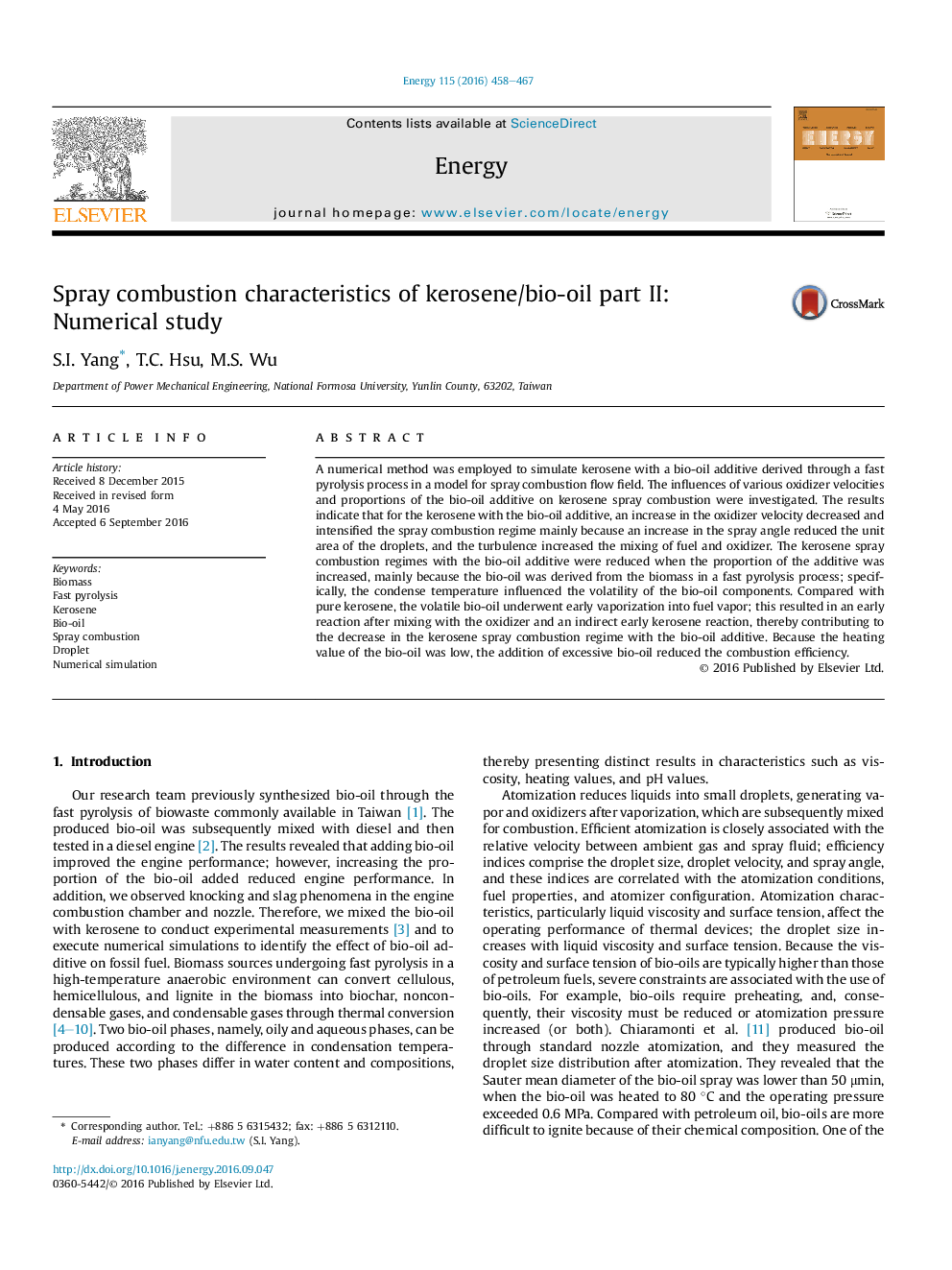| کد مقاله | کد نشریه | سال انتشار | مقاله انگلیسی | نسخه تمام متن |
|---|---|---|---|---|
| 5476687 | 1399206 | 2016 | 10 صفحه PDF | دانلود رایگان |
عنوان انگلیسی مقاله ISI
Spray combustion characteristics of kerosene/bio-oil part II: Numerical study
ترجمه فارسی عنوان
اسپری ویژگی های احتراق نفت سفید / روغن زیتون بخش دوم: مطالعه عددی
دانلود مقاله + سفارش ترجمه
دانلود مقاله ISI انگلیسی
رایگان برای ایرانیان
کلمات کلیدی
زیست توده، پیرولیز سریع نفت سفید روغن زیتون، اسپری اسپری، قطره، شبیه سازی عددی،
ترجمه چکیده
یک روش عددی برای شبیه سازی نفت سفید با استفاده از افزودنی زیستی نفتی حاصل از یک فرایند سریع پیرولیز در یک مدل برای میدان جریان احتراق اسپری استفاده شده است. تأثیرات سرعت های مختلف اکسید کننده و نسبت افزودنی زیستی روغن بر احتراق اسپری های نفتی مورد بررسی قرار گرفت. نتایج نشان می دهد که برای نفت سفید با افزودنی زیستی روغن، افزایش سرعت اکسید کننده کاهش و تشدید سیستم رایت اسپری به طور عمده به این دلیل که افزایش زاویه اسپری سطح واحد قطرات را کاهش داد، و آشفتگی مخلوط سوخت و اکسید کننده. رژیمهای احتراق اسپری نفت سفید با افزودنی زیستی روغن هنگامی که نسبت افزودنی افزایش می یابد، به طور عمده افزایش می یابد، به همین دلیل است که روغن زیستی از بیوماس در یک فرایند سریع پیرولیز مشتق شده است؛ به طور خاص، دمای کنجد بر نوسانات اجزای بیولوژیکی نفت تاثیر گذاشت. در مقایسه با نفت سفید خالص، روغن زیستی فرار، تبخیر اولیه را به بخار سوخت تبدیل کرد. این امر منجر به واکنش اولیه پس از مخلوط شدن با اکسید کننده و واکنش سریع نسوز نفتی، به این ترتیب موجب کاهش رژیم احتراق اسپری نفت با افزودنی زیستی روغن می شود. از آنجا که مقدار گرمای زیستی نفت کم بود، افزودن روغن زیستی بیش از حد باعث کاهش کارایی احتراق شد.
موضوعات مرتبط
مهندسی و علوم پایه
مهندسی انرژی
انرژی (عمومی)
چکیده انگلیسی
A numerical method was employed to simulate kerosene with a bio-oil additive derived through a fast pyrolysis process in a model for spray combustion flow field. The influences of various oxidizer velocities and proportions of the bio-oil additive on kerosene spray combustion were investigated. The results indicate that for the kerosene with the bio-oil additive, an increase in the oxidizer velocity decreased and intensified the spray combustion regime mainly because an increase in the spray angle reduced the unit area of the droplets, and the turbulence increased the mixing of fuel and oxidizer. The kerosene spray combustion regimes with the bio-oil additive were reduced when the proportion of the additive was increased, mainly because the bio-oil was derived from the biomass in a fast pyrolysis process; specifically, the condense temperature influenced the volatility of the bio-oil components. Compared with pure kerosene, the volatile bio-oil underwent early vaporization into fuel vapor; this resulted in an early reaction after mixing with the oxidizer and an indirect early kerosene reaction, thereby contributing to the decrease in the kerosene spray combustion regime with the bio-oil additive. Because the heating value of the bio-oil was low, the addition of excessive bio-oil reduced the combustion efficiency.
ناشر
Database: Elsevier - ScienceDirect (ساینس دایرکت)
Journal: Energy - Volume 115, Part 1, 15 November 2016, Pages 458-467
Journal: Energy - Volume 115, Part 1, 15 November 2016, Pages 458-467
نویسندگان
S.I. Yang, T.C. Hsu, M.S. Wu,
